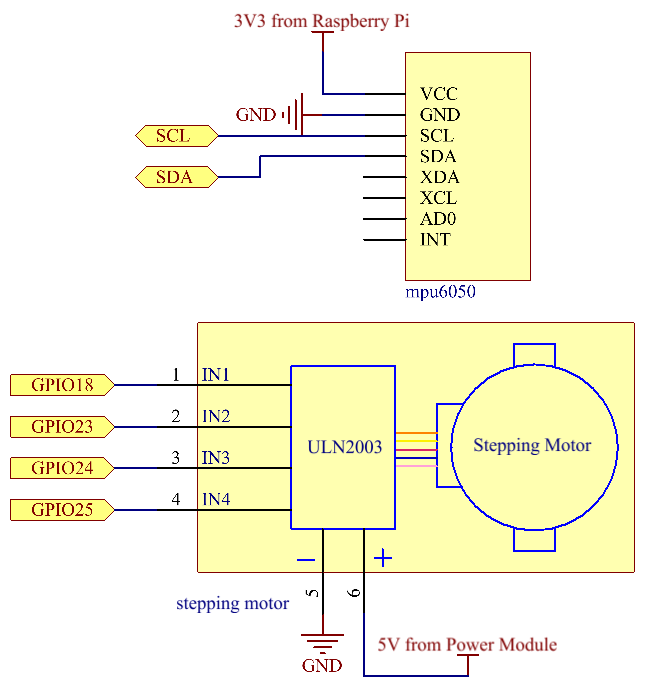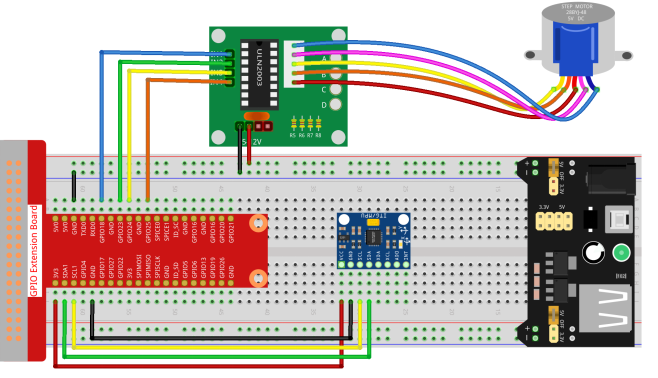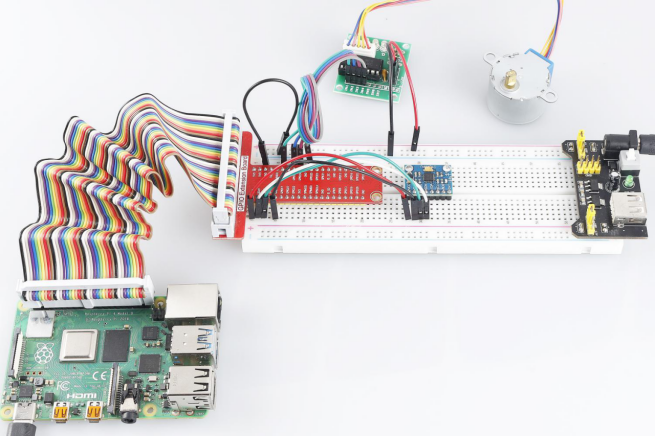Introduction
In this lesson, we will make a simple motion sensing and controlling device. The MPU6050 is used as a sensor and the stepper motor as a controlled device. With the MPU6050 mounted on the glove, you can control the stepper motor by rotating your wrist.
Components

Schematic Diagram
| T-Board Name | physical | wiringPi | BCM |
| GPIO18 | Pin 12 | 1 | 18 |
| GPIO23 | Pin 16 | 4 | 23 |
| GPIO24 | Pin 18 | 5 | 24 |
| GPIO25 | Pin 22 | 6 | 25 |
| SDA1 | Pin 3 | ||
| SCL1 | Pin 5 |

Experimental Procedures
Step 1: Build the circuit.

- For C Language Users
Step 2: Go to the folder of the code.
cd /home/pi/davinci-kit-for-raspberry-pi/c/3.1.6/Step 3: Compile the code.
gcc 3.1.6_MotionControl.c -lwiringPiStep 4: Run the executable file.
sudo ./a.outAs the code runs, if the tilt angle of mpu6050 on the Y–axis is larger than 45 ℃, the stepper motor rotates anticlockwise; if less than -45 ℃, the stepper motor rotates clockwise.
Code Explanation
double mpu6050(){
acclX = read_word_2c(0x3B);
acclY = read_word_2c(0x3D);
acclZ = read_word_2c(0x3F);
acclX_scaled = acclX / 16384.0;
acclY_scaled = acclY / 16384.0;
acclZ_scaled = acclZ / 16384.0;
double angle=get_y_rotation(acclX_scaled, acclY_scaled, acclZ_scaled);
return angle;
}mpu6050 gets the tilt angle in the direction of the Y–axis.
void rotary(char direction){
if(direction == 'c'){
for(int j=0;j<4;j++){
for(int i=0;i<4;i++)
{digitalWrite(motorPin[i],0x99>>j & (0x08>>i));}
delayMicroseconds(stepSpeed);
}
}
else if(direction =='a'){
for(int j=0;j<4;j++){
for(int i=0;i<4;i++)
{digitalWrite(motorPin[i],0x99<<j & (0x80>>i));}
delayMicroseconds(stepSpeed);
}
}
}If the received direction key is ‘c’, the stepper motor rotates clockwise; if the key is ‘a’, the motor rotates anticlockwise. Refer to 1.3.3 Stepper Motor for more details about the calculation of the rotating direction of the stepper motor.
int main()
{
setup();
double angle;
while(1) {
angle = mpu6050();
if (angle >=45){rotary('a');}
else if (angle<=-45){rotary('c');}
}
return 0;
}The tilt angle in the direction of the Y-axis is read from mpu6050, and if it’s larger than 45℃, the stepper motor rotates anticlockwise; if less than -45 ℃, the stepper motor rotates clockwise.
- For Python Language Users
Step 2: Go to the folder of the code.
cd /home/pi/davinci-kit-for-raspberry-pi/python/Step 3: Run the executable file.
sudo python3 3.1.6_MotionControl.pyAs the code runs, if the tilt angle of mpu6050 on the Y–axis is larger than 45 ℃, the stepper motor rotates anticlockwise; if less than -45 ℃, the stepper motor rotates clockwise.
Code Explanation
def mpu6050():
accel_xout = read_word_2c(0x3b)
accel_yout = read_word_2c(0x3d)
accel_zout = read_word_2c(0x3f)
accel_xout_scaled = accel_xout / 16384.0
accel_yout_scaled = accel_yout / 16384.0
accel_zout_scaled = accel_zout / 16384.0
angle=get_y_rotation(accel_xout_scaled, accel_yout_scaled, accel_zout_scaled)
return anglempu6050 gets the tilt angle in the direction of the Y–axis.
def rotary(direction):
if(direction == 'c'):
for j in range(4):
for i in range(4):
GPIO.output(motorPin[i],0x99>>j & (0x08>>i))
time.sleep(stepSpeed)
elif(direction == 'a'):
for j in range(4):
for i in range(4):
GPIO.output(motorPin[i],0x99<<j & (0x80>>i))
time.sleep(stepSpeed)If the received direction key is ‘c’, the stepper motor rotates clockwise; if the key is ‘a’, the motor rotates anticlockwise. Refer to 1.3.3 Stepper Motor for more details about the calculation of the rotating direction of the stepper motor.
def loop():
while True:
angle=mpu6050()
if angle >=45 :
rotary('a')
elif angle <=-45:
rotary('c')The tilt angle in the direction of the Y-axis is read from mpu6050, and if it’s larger than 45℃, rotary() is called to let the stepper motor rotate anticlockwise; if less than -45 ℃, the stepper motor rotates clockwise.
Phenomenon Picture

